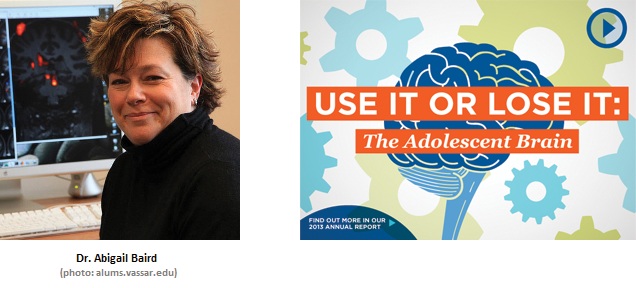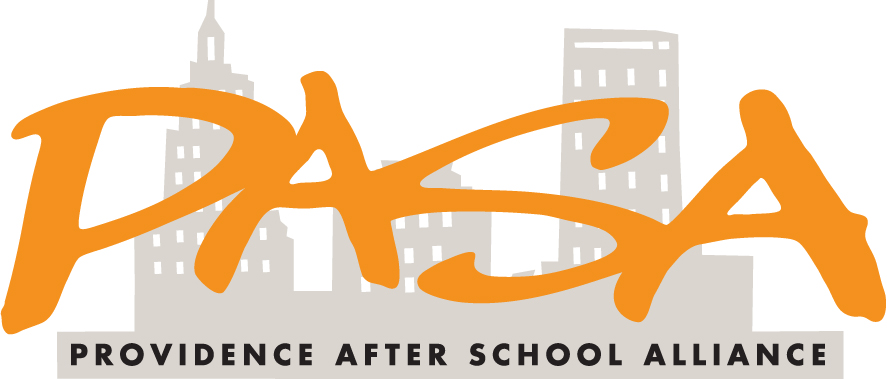
This post was generously shared by TASC, one of PASA’s Every Hour Counts partners, and originally appeared as part of their NeuroConnections blog series, where they explore the bridge between neuroscience and education. Saskia Traill is TASC’s vice president for policy and research. Dr. Abigail A. Baird is Associate Professor of Psychology at Vassar.
The following is an excerpt from their lively and enlightening conversation about the adolescent brain. Dr. Baird will also be appearing in Providence as part of PASA’s 10th Birthday Bash celebration on October 23. Her event is free to the public, so we hope this conversation inspires you to join us!
How are adolescent brains different from adult brains?
This question could fill volumes, and has. Perhaps the biggest difference is that the adolescent brain is still extremely “plastic,” meaning it is still structurally and functionally flexible. Adolescence is the best time to acquire the “rules of the road” for adult behavior. Yet, the social and emotional complexities of societies are highly idiosyncratic. Fortunately, the adolescent brain is ready for anything. It’s similar to how we acquire spoken language. We don’t come hardwired for a particular language because we don’t know where we will be born. Because of this need for flexibility, the brain comes with a strong capacity for language, not the language itself. Likewise, the adolescent brain is uniquely set up to quickly learn socially relevant information, and in doing so, ensure the individual’s survival.
What happens to the brain during adolescence?
A lot. Okay, that is probably not the answer you are looking for, but in all sincerity there is so much happening that it is hard to describe in a limited space. Maybe one way to think about it is like moving into a new house. In order for it to feel like “home,” you have to live in that house for a while, figure out which colors and spaces work, which areas may need renovation, etc. This is a lot like what happens in the adolescent brain; you are transitioning into a new space where you are reproductively viable and therefore eligible for adult status (although our culture delays this process by quite a few years). Your body and brain undergo a great deal of change to accommodate this new status. There are parts of the brain that become smaller and parts that become bigger; there are regions that communicate more frequently and some that stop talking altogether. The key to understanding adolescent brain development is to realize that, just as with the body, the adolescent brain is becoming increasingly coordinated, and this coordination is what enables an adolescent to learn how to be a culturally appropriate adult. While the brain does not change in size (we have an adult-sized brain by the time we are 5 years old), it changes in organization and coordination. Eventually, your behavior feels like “home.”
What are the biggest misconceptions about adolescent development?
Well, there are two that come to mind. The first is that it is a crucible everyone is forced to endure that borders on pathological. Adolescence, in my opinion, is the most functional stage in human development because it enables you to become an adult. Yes it can be stressful, but it is not inherently pathological. Think of the fun you had during adolescence. It’s hard to have that much fun (especially the thrilling kind) as an adult. Adolescents are capable of amazing things because of their developmental stage. I wish people focused on this more.
The second common misconception is that adolescents “don’t think” before they make decisions. They think a lot, and if anything, they might think too much. Decisions have two large components: the mental work that precedes the behavior, and then the execution of the behavior itself. Science has shown how behavioral regulation improves steadily with chronological age. But being more “impulsive” at a younger age is functional in that it makes it fun to try new things. After all, if children and teens never tried new things, they would never learn. It is actually through this seeming “fault” in the behavioral regulation system that we learn. The mental work that is involved in making a decision relies on past experiences with similar situations. This experience has to be firsthand; it cannot be passive “knowledge.” Consider the following example: teens can tell you why they should wear a bike helmet. They can detail the dangers and accurately explain why this is a smart thing to do. But unless they have had some direct experience with physical injury—or witnessed a bad bike accident—they are unlikely to wear a helmet, despite fully understanding why they should.
What should we keep in mind about the adolescent brain when we design ways to help teens learn?
Building on what I mentioned above, the adolescent brain is starving for experience. Teens need to try things and learn how to both succeed and fail. They need to feel physical and emotional jubilation and pain. Therefore, it’s important to make learning as experiential as possible. Like toddlerhood, most of adolescent learning comes from trial and error. We also must acknowledge the critical importance of peer learning. Few realize what a powerful tool peer pressure can be, but it evolved to help younger adolescents learn everything they needed about their generation as quickly as possible.
What does brain research tell us about school discipline policies, school start times, and the reduction of art and sports from many school schedules?
Let’s begin by saying that the vast majority of brain research has supported what good teachers have always known. In terms of discipline, a strong connection with adults whom they do not want to disappoint is one of the best ways to prevent undesirable behavior in teens. Adults need to model the desired behavior, and be willing to give adolescents the space to make mistakes and, more importantly, try again. The adolescent brain is highly sensitive to reward, so setting up scenarios where teens can feel good about “doing the right thing” is really important. We also know that teens are developing their sense of self, so when it comes to discipline, it is critical to impose consequences without shame. All teens should be treated as works in progress, good people who are prone to mistakes. Think of how much patience we have for toddlers. Yes, teens are older, but they are dealing with even more complex and rapid changes. Adolescence is an opportunity to become a great adult, and our job is to get them there.
Regarding school start times—science shows that they need more sleep because their bodies and minds are growing at an unprecedented rate (matched only by toddlerhood) and there is a biological shift in the circadian rhythm of most teens that makes it easy to stay up late, but hard to get up early. Teachers will tell you that later start times, breaks during the day and well-rested teens make better students.
As far as eliminating non-academic activities, it’s among one of the worst things you could do to an adolescent brain. How many academic facts do you remember from middle school? At the same time, how well do you remember the social interactions and personal exploration that happened during those years? Removing the opportunity for adolescents to acquire experience outside traditional classroom studies borders on criminal, in my opinion.

